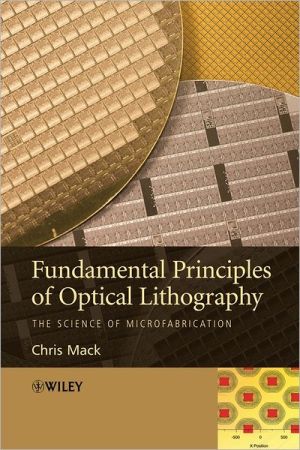

 |

|

Sold Out
Book Categories |
Preface.
1. Introduction to Semiconductor Lithography.
1.1 Basics of IC Fabrication.
1.2 Moore’s Law and the Semiconductor Industry.
1.3 Lithography Processing.
Problems.
2. Aerial Image Formation – The Basics.
2.1 Mathematical Description of Light.
2.2 Basic Imaging Theory.
2.3 Partial Coherence.
2.4 Some Imaging Examples.
Problems.
3. Aerial Image Formation – The Details.
3.1 Aberrations.
3.2 Pupil Filters and Lens Apodization.
3.3 Flare.
3.4 Defocus.
3.5 Imaging with Scanners Versus Steppers.
3.6 Vector Nature of Light.
3.7 Immersion Lithography.
3.8 Image Quality.
Problems.
4. Imaging in Resist: Standing Waves and Swing Curves.
4.1 Standing Waves.
4.2 Swing Curves.
4.3 Bottom Antirefl ection Coatings.
4.4 Top Antirefl ection Coatings.
4.5 Contrast Enhancement Layer.
4.6 Impact of the Phase of the Substrate Refl ectance.
4.7 Imaging in Resist.
4.8 Defi ning Intensity.
Problems.
5. Conventional Resists: Exposure and Bake Chemistry.
5.1 Exposure.
5.2 Post-Apply Bake.
5.3 Post-exposure Bake Diffusion.
5.4 Detailed Bake Temperature Behavior.
5.5 Measuring the ABC Parameters.
Problems.
6. Chemically Amplifi ed Resists: Exposure and Bake Chemistry.
6.1 Exposure Reaction.
6.2 Chemical Amplifi cation.
6.3 Measuring Chemically Amplifi ed Resist Parameters.
6.4 Stochastic Modeling of Resist Chemistry.
Problems.
7. Photoresist Development.
7.1 Kinetics of Development.
7.2 The Development Contrast.
7.3 The Development Path.
7.4 Measuring Development Rates.
Problems.
8. Lithographic Control in Semiconductor Manufacturing.
8.1 Defi ning Lithographic Quality.
8.2 Critical Dimension Control.
8.3 How to Characterize Critical Dimension Variations.
8.4 Overlay Control.
8.5 The Process Window.
8.6 H–V Bias.
8.7 Mask Error Enhancement Factor (MEEF).
8.8 Line-End Shortening.
8.9 Critical Shape and Edge Placement Errors.
8.10 Pattern Collapse.
Problems.
9. Gradient-Based Lithographic Optimization: Using the Normalized Image Log-Slope.
9.1 Lithography as Information Transfer.
9.2 Aerial Image.
9.3 Image in Resist.
9.4 Exposure.
9.5 Post-exposure Bake.
9.6 Develop.
9.7 Resist Profi le Formation.
9.8 Line Edge Roughness.
9.9 Summary.
Problems.
10. Resolution Enhancement Technologies.
10.1 Resolution.
10.2 Optical Proximity Correction (OPC).
10.3 Off-Axis Illumination (OAI).
10.4 Phase-Shifting Masks (PSM).
10.5 Natural Resolutions.
Problems.
Appendix A. Glossary of Microlithographic Terms.
Appendix B. Curl, Divergence, Gradient, Laplacian.
Appendix C. The Dirac Delta Function.
Index.
Login|Complaints|Blog|Games|Digital Media|Souls|Obituary|Contact Us|FAQ
CAN'T FIND WHAT YOU'RE LOOKING FOR? CLICK HERE!!! X
 You must be logged in to add to WishlistX
 This item is in your Wish ListX
 This item is in your CollectionFundamental Principles of Optical Lithography: The Science of Microfabrication
X
 This Item is in Your InventoryFundamental Principles of Optical Lithography: The Science of Microfabrication
X
 You must be logged in to review the productsX
 X
 X

Add Fundamental Principles of Optical Lithography: The Science of Microfabrication, The fabrication of an integrated circuit requires a variety of physical and chemical processes to be performed on a semiconductor substrate. In general, these processes fall into three categories: film deposition, patterning, and semiconductor doping. Fil, Fundamental Principles of Optical Lithography: The Science of Microfabrication to the inventory that you are selling on WonderClubX
 X

Add Fundamental Principles of Optical Lithography: The Science of Microfabrication, The fabrication of an integrated circuit requires a variety of physical and chemical processes to be performed on a semiconductor substrate. In general, these processes fall into three categories: film deposition, patterning, and semiconductor doping. Fil, Fundamental Principles of Optical Lithography: The Science of Microfabrication to your collection on WonderClub |